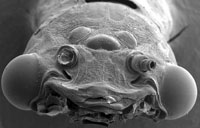Ten Sources of Lethal Infection You Contact Every Day
A gauze bandage is not the best remedy against germs and viruses. The best place to start a war with germs is your household, and this article will prompt you where to look for the enemy.

Kitchen Sinks
According to British scientists, one cm2 of the surface near or inside a kitchen sink houses on average up to 80,000 bacteria. Bacteria enjoy feeding on food scraps that are extremely hard to remove completely, and quickly multiple in this favorable environment.
There is a great deal of bacteria on a kitchen tap, where dirt and scraps get with splashes of water. A kitchen sponge or rag is the number one source of germs in the entire house.
Solution. Don’t be lazy and wash your sink and tap after each cooking or dish washing session. Use detergents to kill bacteria since simple rinsing with warm water is not good enough to prevent bacteria from breeding.
Don’t forget to wash sponges and rags when you are done cleaning.
Cutting Boards
According to the US FDA, potatoes, berries, and leafy greens are the most probable sources of germs. When you chop any of these products on a cutting board, there is a good chance that both the board and knife are contaminated. Bacteria will transfer easily to other food and later, your stomach.
Solution. First, carefully wash all fruit and vegetables before consumption, and cook your meat at high temperatures. Second, wash your cutting boards with soap. Make sure you have separate cutting boards for different food groups.
Remember that traditional wooden boards are the best breeding ground for bacteria. Glass and plastic are less prone to be affected by germs. Cracked or scratched cutting boards should be replaced since all indents are potential germs’ hideouts.
Washed Clothes
Tiny particles of human waste stay on clothes and linens even after a rigorous wash. Bacteria also survive and start multiplying in humid and warm environment inside a washing machine. When you take your clothes out of the washer to dry it, germs can get onto your hands and then your mouth, stomach, etc.
Solution. Most bacteria die at 149F, so make sure your washer warms the water to this temperature. If you hand wash your clothes, use mild bleach that will kill up to 99% of bacteria. Do not wash underwear together with linens and outwear.
Do not forget to wash your hands after you are done handling your washed clothes.
Toothbrushes
One mm2 of oral mucosa houses up to 100 million of germs. When you brush your teeth, your toothbrush does not kill bacteria, it only collects them. It also collects food scraps, which makes it a perfect environment for bacteria breeding.
Solution. Wash your toothbrush with hot water after using and put it in a special stand where it will not dry out. Do not put your brush on a bathroom shelf where it is exposed to other germs and do not put it in a case.
Shower Heads
Last year, scientists from Simmons College Center for Hygiene and Health in Home and Community studied bathrooms of several thousands of volunteers to find Staphylococcus aureus bacteria in nearly a quarter of them. Bacteria lived on shower heads and would spread to the owners’ hair every time they took a shower. The bacteria also liked corners, cracks between tiles, shelves corners, sinks and other places that are always wet and hard to clean.
Solution. Clean your bathroom with disinfecting detergents and air it often to avoid excessive humidity. You can also install a bathroom fan that turns on every time the light is on. You could also keep the bathroom door open.
Keyboards and Phone Receivers
Any technical device you touch hundreds of times a day may shelter flu viruses, staphylococcus bacteria and other unpleasant germs. As for a computer keyboard, within a year of use it becomes significantly heavier because of dirt and food scraps that stick to it. It is a perfect environment for germs.
Solution. Clean your receivers, mouse, screen and other devices with moist wipes and clean your keyboard at least once a month. Try not to eat while working at a computer, and wash your hands before you start working.
Toilet Floors
Surprisingly, there are more bacteria on toilet floors than on toilet seats. It has to do with splashes of water while flushing that transfer fecal particles and bacteria to the floor and even walls.
Solution. Close your toilet lid before you flush. Wash floors in your toilet at least once a week and use detergents. Wash toilet rug in hot water and dry it before putting it back on the floor.
Shoes
Even if you are not a walker, hundreds of thousands of germs stick to your shoes as soon as you leave the house. You bring them all home where they easily spread.
Solution. Place a doormat outside of your house and change shoes when you get indoors, Wipe your street shoes carefully and wash the soles.
Beds
Constant warmth and humidity allow bacteria spreading easily and quickly in our beds. Bacteria also feed of human skin micro-particles. The most common issue is the so called house dust mites that cause allergies similar in symptoms to a bad cold or even asthma.
Solution. Wash your sheets once a week. House dust mites die at 122F without special disinfection detergents. Do not keep piles of unwashed clothes in your bedroom since it is a good place for bacteria breeding.
Dust Collectors
These are all places and household objects you have no time to clean. They include surfaces of tall cabinets, chandeliers, knick-knacks, etc. Theoretically, germs are not capable of living in dust itself since it is not humid enough, but they can feed on dust particles. Dust may contain remnants of chemical cleaning solutions that may also cause allergies.
Solution . Clean your house with moist rags at least once a week. If you are using a vacuum cleaner, make sure you clean not only floors and carpets but also furniture, shelves and closets. The most radical solution is minimizing all decorations and tchotchke.
Aif.ru
Subscribe to Pravda.Ru Telegram channel, Facebook, RSS!




